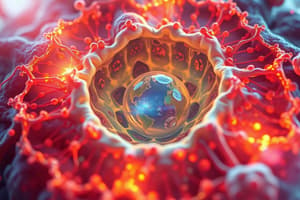Podcast
Questions and Answers
The smallest unit of life is called a molecule.
The smallest unit of life is called a molecule.
False (B)
The structure of a cell is directly related to its function in organisms.
The structure of a cell is directly related to its function in organisms.
True (A)
All organisms consist of more than one cell.
All organisms consist of more than one cell.
False (B)
Cells are only found in complex multicellular organisms.
Cells are only found in complex multicellular organisms.
In biology, the term 'cell' refers only to the nucleus of an organism.
In biology, the term 'cell' refers only to the nucleus of an organism.
Match the following terms related to force and motion with their definitions:
Match the following terms related to force and motion with their definitions:
Match the following types of motion with their descriptions:
Match the following types of motion with their descriptions:
Match the following forces with their examples:
Match the following forces with their examples:
Match the following laws of motion with their statements:
Match the following laws of motion with their statements:
Match the following terms with their units of measurement:
Match the following terms with their units of measurement:
Flashcards are hidden until you start studying
Study Notes
Cell as the Fundamental Unit of Life
- Cells are the basic building blocks of all living organisms.
- Structure of cells varies widely, reflecting diverse functions in different organisms.
- Components of a cell include the cell membrane, nucleus, cytoplasm, and organelles, each with specific functions.
Relationship to Overall Biology
- Cell functions are critical for maintaining homeostasis in organisms.
- Specialized cells differentiate to perform distinct roles (e.g., muscle cells for movement, nerve cells for signaling).
- Organisms are classified based on cell type: prokaryotic (single-celled, no nucleus) and eukaryotic (multi-celled, nucleus present).
Forces and Motion
- Forces are influences that can change the motion of objects; they can push or pull.
- Motion is described in terms of distance, speed, velocity, and acceleration.
- Newton's Laws of Motion describe the relationship between the forces acting on an object and its motion.
Understanding Motion
- An object at rest stays at rest unless acted upon by a net external force (Newton's First Law).
- Objects in motion continue to move at a constant speed and in a straight line unless acted upon by a net force.
- Acceleration occurs when a net force is applied, changing an object’s speed or direction (Newton's Second Law).
Analyzing Motion
- Motion can be graphically represented using distance-time graphs and velocity-time graphs.
- The slope of distance-time graphs indicates speed, while the slope of velocity-time graphs indicates acceleration.
- Understanding vector quantities (magnitude and direction) is essential in analyzing motion accurately.
Studying That Suits You
Use AI to generate personalized quizzes and flashcards to suit your learning preferences.




